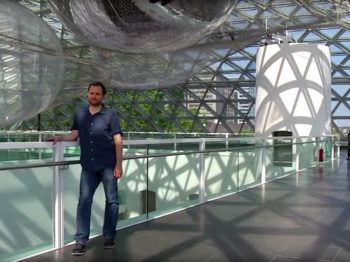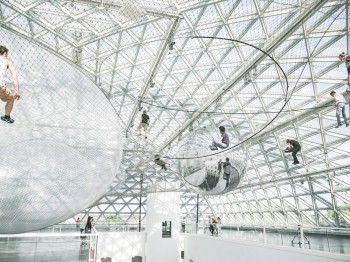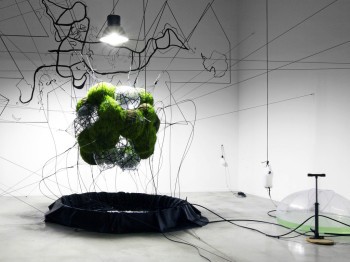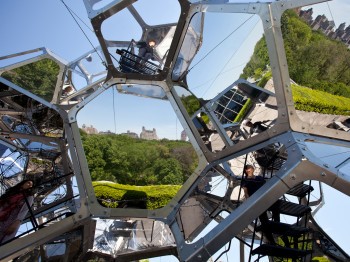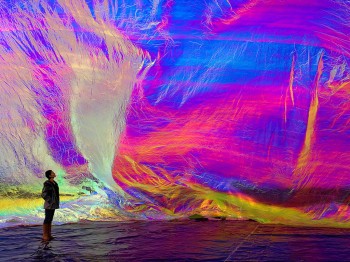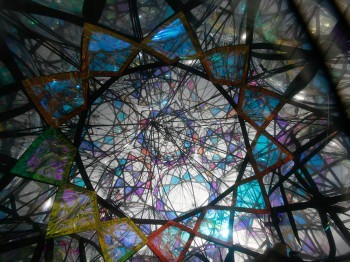Tomás Saraceno
Inaugural Visiting Artist
MIT Center for Art, Science & Technology
Inflatable and airborne biospheres that expand our thermodynamic imagination
About the Residency
An artist trained as an architect, Tomás Saraceno deploys insights from engineering, physics, chemistry, aeronautics and materials science in his work. He creates inflatable and airborne biospheres with the morphology of soap bubbles, spider webs, neural networks or cloud formations, which are speculative models for alternate ways of living for a sustainable future. As a CAST Visiting Artist, Saraceno has drawn from a vast array of expertise in departments across the Institute and developed collaborative projects with the Department of Civil and Environmental Engineering and Department of Earth, Atmospheric and Planetary Sciences. His ongoing residency has focused on advancing new work for the ongoing Cloud Cities, Hybrid Webs and Aerocene series.
Saraceno’s investigation of the intricate geometry of spiderwebs aligned with research by Markus Buehler, Professor and Head, MIT Civil and Environmental Engineering, on the complex, hierarchal structure of spider silk and its amazing strength. Saraceno developed an original tomographic method, using a laser sheet, to scan a three-dimensional web and make accurate three-dimensional data of the web. Buehler’s lab created a computer simulation of the data set generated by this project to reveal how the strands behave and interact in the physical web. Subsequently, Saraceno and Buehler developed new mechanisms for tracking spiders, scanning webs and generating computer models.
As a CAST Visiting Artist, Saraceno has participated in numerous public programs and symposia including the 2014 CAST Symposium “Seeing / Sounding / Sensing.” Saraceno’s 2012 project On Space Time Foam was the stimulus for “Sensing,” the symposium’s discussion on current understandings in neuroscience about the human capacity for joint action and bodily awareness. On Space Time Foam is a multi-layered installation of plastic membranes suspended 24 meters above the ground. Each level has a different air pressure and reacts to the movement of visitors in each layer, creating an extraordinary interactive experience for its inhabitants and pushing the limitations of physics through experimentation with new materials and techniques.
Saraceno envisions floating cloud-like cities that people might inhabit in the future, which launched his investigation of going “aerosolar” with zero-emission lighter-than-air structures and a collaboration with MIT EAPS meteorologist Lodovica Illari. In 2015 Illari began collaborating with Saraceno on Aerocene, a project to draw attention to the environmental impacts of air pollution and carbon emissions by developing inflatable technology for air transportation using atmospheric physics principles that rely on infrared/solar radiation from the Sun during the day and the Earth at night. Illari, Professor Glenn Flierl and researcher Bill McKenna generate visualizations of potential flight trajectories around the Earth and the best places and seasons for launches using historical atmospheric data and factors including temperature, pressure, wind strength and direction, and cloud cover. As part of this ongoing collaboration, Illari and Flierl have developed simulated flight patterns under real-world conditions and visualizations that allow the public to think about “Aerocene” in relation to climate science.
More about Aerocene.
Presented by the MIT Center for Art, Science & Technology (CAST).
Schedule
Past Events
Spider’s Canvas/Arachnodrone
MIT Sounding Concerts: February 16-18, 2019
On Display: Spring 2019
ON AIR
Exhibition on view: October 17, 2018 – June 1, 2019
Palais de Tokyo, Paris
Spider’s Canvas (performance commissioned by Saraceno for ON AIR)
November 23, 2018
Palais de Tokyo, Paris
Aerocene and the Future in a Fossil-Free World
Thursday, April 19, 2018
6:00-7:30pm / Panel Discussion
MIT Lecture Hall 10-250
222 Memorial Drive, Cambridge, MA 02139
7:30pm / Reception
MIT Memorial Lobby, Building 10
222 Memorial Drive, Cambridge, MA 02139
MIT Visiting Artist Tomás Saraceno, MIT Senior Lecturer in Meteorology Lodovica Illari, Professor of Atmospheric Chemistry Daniel Cziczo and Morningstar Professor of Physics Robert Jaffe discuss how the solar-powered sculptures of the Aerocene project inspire us to think of a different way to interact with the environment. A panel discussion will be moderated by Professor John Fernández, director of MIT’s Environmental Solutions Initiative. Reception to follow in Lobby 10.
Aerocene Explorer Performance & Interactive Display with MIT Visiting Artist Tomás Saraceno and EAPS Scientists
April 20 & 21, 2018 / 11:00am-2:00pm
MIT Killian Court and Memorial Lobby, Building 10
222 Memorial Drive, Cambridge, MA 02139
Take part in flights of solar sculptures that become buoyant and lift off the ground powered only by the heat of the sun. Use them to take measurements of weather variables and pollutants in the atmosphere’s boundary layer. Learn more about atmospheric winds that make sustainable flight possible through an interactive display. Bring a picnic lunch!
Presented in conjunction with the Climate Changed Symposium and Cambridge Science Festival.
World Economic Forum Annual Meeting
Presentation of Aerocene with Lodovica Illari and Glenn Flierl, EAPS
January 17-20, 2017
Davos-Klosters, Switzerland
COP21 Paris Climate Change Conference
December 17, 2015
Palais De Tokyo, Paris, France
Panel: “Moving Beyond Materiality” with Tomás Saraceno, Nader Tehrani, NADAAA and Antón García-Abril, Ensamble Studio
Thursday, November 15, 2015 / 6:30pm
Active Matter Summit: Active Architectures Panel
“Material Environments” Tomás Saraceno
Saturday, April 25, 2015 / 3:15–4:45pm
Bartos Theater, E15-070
20 Ames Street, Cambridge, MA
Reverberations: A Conversation between Visiting Artist Tomás Saraceno and Markus Buehler, Professor and Head, Civil and Environmental Engineering, MIT
Moderated by John Ochsendorf, Class of 1942 Professor of Architecture and Civil and Environmental Engineering, MIT
Thursday, September 25, 2014 / 7:00pm
MIT Museum
265 Massachusetts Avenue, Cambridge MA
Panel: “Sensing – Actions”
Discussion as part of CAST symposium “Seeing / Sounding / Sensing”
September 27, 2014 / 2:00–5:00pm
Media Lab, E14-674 (6th Floor)
75 Amherst St, Cambridge MA
Class Visits
April 2015
Civil & Environmental Engineering Design, 1.013
Active Architectures, 4.022
October 2012
Nano-Machines, 4.112
The Art/Science Thing, 4.S62
Exploratory Research
October 2012
History + Theory of Architecture and Art
School of Architecture + Planning Visit to Science, Technology, and Society
School of Humanities, Arts, and Social Sciences
Program in Atmospheres, Oceans and Climates Department of Earth, Atmospheric and Planetary Sciences
Building Technology Group
Horvitz Laboratory Department of Biology
Collaborators at MIT
During his ongoing residency at MIT, Saraceno has met with over twenty scientists, architects and engineers across the Institute for conversations about biomimicry, cosmology, atmosphere and flight.
Markus Buehler, Department Head, MIT Department of Civil and Environmental Engineering
Dörthe M. Eisele, Postdoctoral Associate (2011-14), MIT Center for Excitonics
Glenn R. Flierl, Professor of Oceanography, MIT Department of Earth, Atmospheric and Planetary Sciences
Jerome I. Friedman, Institute Professor, Emeritus, MIT and Nobel Laureate, Physics
Antón García-Abril, Professor of Architecture, MIT and founder, ENSAMBLE STUDIO
Elizabeth Goldring, Fellow (2008-2012), MIT Center for Advanced Visual Studies
Jeffrey Grossman, Morton and Claire Goulder and Family Professor in Environmental Systems, MIT Department of Materials Science and Engineering, MIT Department of Mechanical Engineering
R. John Hansman, T. Wilson Professor of Aeronautics and Astronautics and Director, MIT International Center for Air Transportation
Lodovica Illari, Senior Lecturer, MIT Department of Earth, Atmospheric and Planetary Sciences
Robert Jaffe, Jane and Otto Morningstar Professor of Physics, MIT
Caroline Jones, Professor of the History of Art, MIT Department of Architecture
Bill McKenna, BSc Architecture MIT ’10 and Researcher, MIT Department of Earth, Atmospheric and Planetary Sciences
Les Norford, Professor and Associate Head, MIT Department of Architecture
Otto Piene, Professor Emeritus, MIT Department of Architecture and Director (1974-1994), MIT Center for Advanced Visual Studies (CAVS),
Zhao Qin, Research Scientist, MIT Department of Civil and Environmental Engineering
Nader Tehrani, Professor and Department Head (2007-15), MIT Department of Architecture, and Principal and Founder, NADAAA
Skylar Tibbits, Director, Self-Assembly Lab and Assistant Professor, MIT Department of Architecture
Brian Wardle, Associate Professor of Aeronautics and Astronautics and Director, Necstlab and Nano-Engineered Composite Aerospace Structures Consortium
Rosalind Williams, Bern Dibner Professor of the History of Science and Technology, MIT Program in Science, Technology and Society
J. Meejin Yoon, Professor of Architecture and Department Head, MIT Department of Architecture Undergraduate Program
Biography
Tomás Saraceno’s (b.1973, Argentina) oeuvre could be seen as an ongoing research, informed by the worlds of art, architecture, natural sciences, astrophysics and engineering; his floating sculptures, community projects and interactive installations propose and explore new, sustainable ways of inhabiting and sensing the environment.
In 2015, Saraceno achieved the world record for the first and longest certified fully-solar manned flight. He was the first person to scan, reconstruct and reimagine spiders’ weaved spatial habitats, and possesses the only three-dimensional spider web collection in existence. Saraceno lectures in institutions worldwide, and directed the Institute of Architecture-related Art (IAK) at Braunschweig University of Technology, Germany (2014–2016). In addition to the MIT Center for Art, Science & Technology, he has held residencies at Centre National d’Études Spatiales (2014–2015) and Atelier Calder (2010).
In 2009, Saraceno attended the International Space Studies Program at NASA Ames. The same year he presented a major installation at the 53rd Venice Biennale, and was later awarded the prestigious Calder Prize. His work has been widely exhibited internationally in solo and group exhibitions such as Aerocene, at Solutions COP21, Grand Palais, Paris; Arachnid Orchestra. Jam Sessions, at NTU Centre for Contemporary Art Singapore; Becoming Aerosolar, at 21er Haus, Belvedere, Vienna (all 2015); In orbit, at Kunstsammlung Nordrhein- Westfalen K21, Düsseldorf (2013–ongoing); On the Roof: Cloud City, at The Metropolitan Museum of Art, New York (2012); Cloud Cities, at Hamburger Bahnhof, Berlin (2011–12), amongst others. Saraceno’s work is included in the collections of The Museum of Modern Art, New York; SFMOMA, San Francisco; Walker Art Center, Minneapolis; Nationalgalerie, Staatliche Museen zu Berlin, Berlin; among others.
More at the artist’s website: Tomás Saraceno.
In the Media
“Have you ever wondered what it would feel like to walk on clouds? Well, now you can”
“He’s a great artist, comparable to Marcel Duchamp or even Leonardo da Vinci, who always thought outside and combined disciplines”
— Rebecca Lamarche-Vadel, Curator of Exhibitions at Palais de Tokyo
“Mr. Saraceno’s work is playful, even childlike, yet mind-bogglingly sophisticated and political.”
“This show is a marvel of art and science” — Studio International
Le Monde: Exposition: Tomas Saraceno tricote le fil de l’univers
Numero: Les araignées de Tomás Saraceno envahissent le Palais de Tokyo
The Royal Society: Imaging and analysis of a three-dimensional spider web architecture
The Tech: Citizen science
Télam: Saraceno: La influencia del mundo del arte es mínima
New York Times: Art & Design At M.I.T., Science Embraces a New Chaos Theory: Art
Art Asia Pacific: Arachnid Orchestra. Jam Sessions
The Creators Project: Tomas Saraceno’s Arachnid Orchestra Weaves Terrifying Arrangements
Studio 360: Caught in Tomas Saraceno’s Web
Designboom: Tomàs Saraceno’s ‘On Space Time Foam’: A Billowing Aerial Landscape
Artfix Daily: Tomás Saraceno is Inaugural Visiting Artist in newly established MIT Center for Art, Science & Technology
Huffington Post: Tomás Saraceno’s Adult Playground ‘On Space Time Foam’ Is An Enormous Suspended Trampoline (PHOTOS)
Vogue Italia: Tomas Saraceno
Architectural Digest, Daily AD: Tomás Saraceno’s New Archtectural Sculptures are on view at Tanya Bonakdar
SciArt in America: Art for the Age of the Anthropocene
Wired: Milan Art Installation Has Visitors Walking on Air
The Metropolitan Museum of Art: Tomás Saraceno on the Roof: Cloud City
Architectural Digest, AD Innovator: Tomás Saraceno
Arch Daily: In Orbit Installation / Tomas Saraceno
Culture Vulture: Tomás Saraceno: Stillness in Motion-Cloud Cities
SFMOMA: Site Specific Installation by Tomás Saraceno
New York Times: Tomás Saraceno at the San Francisco Museum of Modern Art




